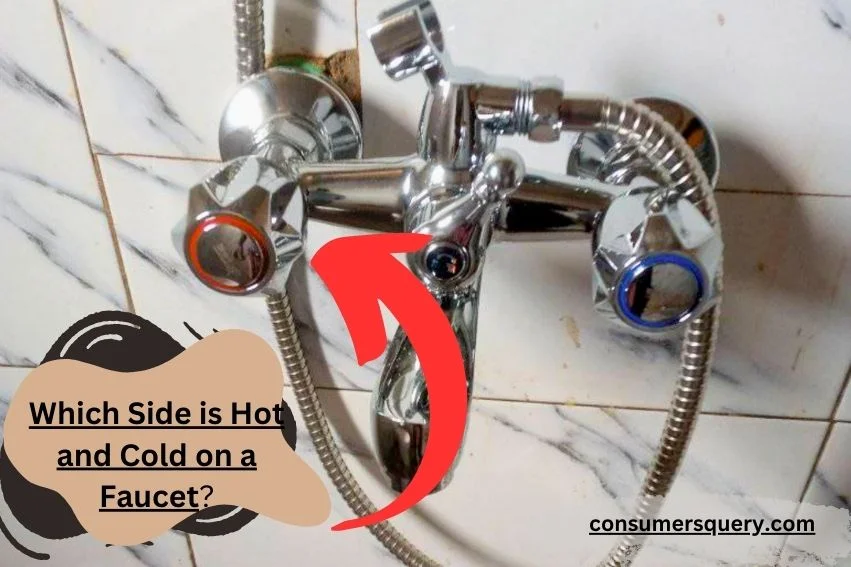Have you ever found yourself standing in front of a faucet, wondering which side is hot and which side is cold? It can be frustrating, especially if you’re in a hurry. But don’t worry, we’re here to help. In this article, we’ll find the mystery of which side is hot and cold on a faucet.
How to Identify the Hot and Cold Sides of a Faucet

When you turn on a faucet, you expect to get the right temperature of water. But what if you don’t know which side is hot and which is cold? Here are some ways to identify the hot and cold sides of a faucet:
Look for Visual Indicators
Most faucets have some sort of visual indicator to help you identify the hot and cold sides. These can include:
- Red and blue handles: Generally, the hot water faucet will have a red handle, while the cold water faucet will have a blue handle. Some faucets may use green instead of blue.
- “H” and “C” markings: Some faucets may have “H” and “C” markings on the handles to indicate which is hot and which is cold.
- Color coding: Some faucets may have different colors for the hot and cold handles. For example, the hot handle may be a darker color than the cold handle.
Feel the Temperature of the Water
If you’re not sure which side is hot and which is cold, you can always feel the temperature of the water. Turn on the faucet and let it run for a few seconds. Then, place your hand under the water to determine which side is hot and which is cold. The hot side will feel warm or hot to the touch, while the cold side will feel cool or cold.
Check the Plumbing Code
In the United States, the Uniform Plumbing Code requires that faucets be connected to the water distribution system so that hot water corresponds to the left side of the fittings. However, not all faucets may follow this standard, especially older faucets. If you’re not sure which side is hot and which is cold, it’s always a good idea to check the plumbing code or consult a professional.
Why is the hot side typically on the left?
Have you ever wondered why the hot water faucet is typically on the left side of a sink? Well, the tradition of having the hot water faucet on the left is thought to have originated in the 19th century when indoor plumbing was first introduced.
Since most people are right-handed, it made sense to place the pump that supplied cold water on the right side of the sink. When hot water was introduced, it was simply placed on the opposite side. This way, people could use their dominant hand to pump water and not have to reach across their body to access the cold water.
The reasoning behind this tradition is simple and practical. It makes sense to have a consistent standard for which side is hot and cold on a faucet. This way, people can easily and quickly identify which side to turn on for hot water, and which side to turn on for cold water. It also helps to prevent accidents, such as accidentally scalding oneself with hot water.
Are there any exceptions to the rule?
While it’s generally true that hot water faucets are on the left and cold water faucets are on the right, there are some exceptions to this rule. These exceptions are more likely to be found in older homes or in buildings where the plumbing has not been updated.
In these cases, it’s possible that the hot water faucet is on the right and the cold water faucet is on the left. This can be confusing, so it’s important to check the label or marking on the faucet to be sure which side is hot and which side is cold.
Another exception to the rule is faucets with single-lever handles. These types of faucets may not have any visual indicators for which side is hot and which side is cold. In this case, you will need to experiment with the handle to find the right temperature for your needs.
It’s also worth noting that some newer faucets may have different markings or labels for hot and cold water. For example, some faucets may use blue for cold water and red for hot water, while others may use symbols or letters to indicate which side is hot and which side is cold.
Why are Some Faucets Only Providing Hot Water and Others Not?
If you are experiencing troubleshooting hot water issues, you may wonder why some faucets only provide hot water while others do not. This can be due to several reasons, such as a faulty or worn-out faucet cartridge, a malfunctioning mixing valve, or even a problem with the water heater itself. It is advisable to consult a professional plumber to diagnose and resolve the issue efficiently.
Tips for Avoiding Accidental Scalding
Accidental scalding is a serious problem that can cause severe burns and injuries, especially for young children and the elderly. Here are some practical tips to help you avoid accidental scalding and ensure hot water safety in your home:
Following these tips will help you avoid accidental burns from hot water and keep your home safe. Scalds from hot water can be very harmful, even fatal, so make sure to be cautious about hot water safety.

Leave a Reply